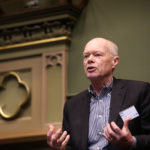Head space for creativity and innovation
How can we move beyond the what to the why of innovation? At the recent GAP Summit Dr Melis Senova called for nothing less than a collective mindset revolution.
Good morning all, I’d like to begin by acknowledging the traditional people of this land upon which we meet today, the Gadigal Clan of the Eora Nation, and extend my respect to their elders, past and present.
I often wonder about the original peoples around the globe, those who tens of thousands of years ago knew how to live in complete harmony with the Earth—those so connected with our planet, their instincts guided their survival and development as a community.
I wonder how they spoke about innovation.
Our dialogue about innovation is too focussed on the what—the process, the infrastructure, the policies… and less on the why—why do we want to innovate? I think we need to broaden our focus on innovation from what and how to include why. I believe this shift is going to require a collective mindset revolution—to ensure our efforts around innovation are effective.
We need to think about how we redesign the struggling super systems like education, health, finance, and make sure we create better, future alternatives in an innovative and meaningful way.
Over the duration of my career the biggest area of poverty I see is in a mindset conducive to innovation and creative problem solving.
So to address this, and in conjunction with friend and collaborator Professor Harold Nelson, a former Nierenberg Distinguished Professor of Design at Carnegie Mellon University, we have identified seven different mindsets that we have seen are necessary for innovation to thrive.
It’s a lot to cover in 10 minutes so I’m going to share four of them with you now and how they can be applied to a national think space.
The first and most important is Beginner’s Mind.
To borrow from a Zen concept and respectfully place it into a very pragmatic context, beginner’s mind is a mindset that fosters an attitude of forever learning.
That no matter how much you know about a topic, or how many years’ experience you may have under your belt, there is always more to learn… and often, learning about ourselves, and how we think and act, is more impactful than increasing our expertise in our chosen area.
A beginner’s mind is the base mindset. It sets up the conditions for the other mindsets to be possible. Without the belief we have more to learn, we are more closed minded than perhaps we think we are, less curious and most importantly less likely to explore possibility.
To innovate is to see something new. To see something new in the familiar requires a beginner’s mind.
The second is an Open Mind.
An open mind is one that welcomes new perspectives and belief paradigms. It is a mindset willing to be stretched beyond belief boundaries, to truly understand a different perspective to the one you hold.
When I use the word belief I am not referring specifically to beliefs based on faith, though I am including them in the mix. I’m referring more to the beliefs we either create about ourselves, “I must be successful or I will seem like a failure to my friends and family” or a belief set by society, “having material possession of high quality means I’ve made it”. These beliefs, and we have so many of them, set up boundaries and those belief boundaries are self-reinforcing.
Before doing my PhD in Human Centred Design, I lived in Japan studying brains at a research hospital specialising in stroke and stroke recovery. Our brains are beautiful efficient pattern matching devices, and these beliefs are almost like blueprints. Your brain finds patterns that match the blueprint, these patterns act as evidence that then reinforce your belief.
Having an open mind allows these boundaries to be tested, and stretched, creating a more nimble view point more conducive to creativity and innovative thinking. An open mind does not mean you lack conviction. It doesn’t even mean you need to change your position on a topic. What it does mean is you will most likely learn something that might change your mind, or it might give you another idea, a better idea than the one possible with your current belief system.
In an increasingly technologically interconnected world, where boundaries between nations and cultures are diminishing, having an open mind is an entry criteria for any nation with the ambition to flourish in harmony in the future.
To innovate, we need to be open to possibilities.
Which leads me to the third mindset, the Creative Mind.
Having a creative mindset means you believe anything is possible. It is a mindset that is curious and questioning. One that questions the very systems that have organised society for hundreds of years. It is one that works hard to find unique ways to create sought after outcomes and solutions to complex systemic challenges facing humanity.
A creative mindset does not mean you have to be a creative person. It doesn’t require a PhD in design as the entrance criteria which most like to think (a theory of convenience in my view).
A creative mindset is one that consciously avoids the well-worn “problem to solution” pathway. A way of thinking that is drilled into us during school. That the right answer is best. That the quickest pathway is best.
A creative mindset doesn’t revere answers, it is more interested in asking great questions. It is a mindset that wants to spend the time understanding the real problem first, rather than getting excited about the first solution that comes along to make the problem go away.
A phenomenon I’ve called Solution Seduction.
We exist in increasingly complex dynamic socio-technical systems. These systems are ambiguous and irrational, “we cannot solve challenges we face with the same thinking that created them…” someone famous once said that… and we cannot rely only upon linear thinking to solve ambiguous challenges.
To innovate we need to think creatively and differently to what we have in the past.
The fourth mindset is a Whole Mind.
A holistic mindset is an inclusive and systemic perspective. A whole mind avoids focusing solely on the object of the innovation, but thinks systemically and contextually about how that innovation is going to exist in and over time.
Perhaps we can also say this mindset is more concerned with outcomes, rather than outputs. An example of an output is the creation of an innovation incubator. An example of an outcome is the improved prosperity of the community within which the incubator is placed. Outputs talk about things; Outcomes talk about people.
We are often too focussed on outputs rather than the intended outcomes of these outputs. We need to be thinking about both, always about both.
So for example, our understanding of value in business is not an example of a whole mind. Business is geared around one dimension of value and that is financial value, in all its forms.
A holistic perspective looks at all of the other forms of value exchange possible between a business, the people who work within it, and the people who consume its goods or services—the customers.
Being able to think holistically about what it actually means to be in business, beyond making money, has the potential to fundamentally disrupt the trajectory we are now on regarding people and planet.
To create systemic impact through innovation, we need to think systemically.
And it leads back to the question, why are we innovating?
Purpose and Intention
If we could imagine for a second a world where the mindsets and attitudes I shared earlier were the dominant mindsets in those people responsible for governing our nation, even with this present I think there is still something missing.
Something that will have all our innovation efforts be systemically impactful…
…and that is a sense of Purpose and Intention as a nation.
What is a sense of purpose? It is our ultimate and enduring ‘why’. Why do we exist as a nation? To what end?
Having an Intention gives us a sense of direction. What do we intend to achieve as a nation of 22 million people? Many innovative leaps naturally occur because there is a strong purpose and intention driving those who innovate. If we are interested in setting a national agenda for innovation, we need to focus equal attention on why to innovate as well as what and how we need to enable this innovation.
Our discussions about incubators, or tax breaks, or unique technological infrastructure are important and should continue (with action following close behind). Though this should not be happening in the absence of a clear intention.
“If you don’t know where you are going, any road will take you there.” Lewis Carroll
At the moment, I can’t tell you who Australia wants to be and why we need to innovate.
It is now accepted that innovation leads to economic prosperity, that supporting small to medium enterprises contributes to a more complex economy, another good thing, but why?
A sole focus on creating economic prosperity is not enough. We should be striving for something greater than that. We should be creating a sense of purpose equal to those created by leaders who have gone down in history for uniting a nation around a clear intention.
Here’s what I propose… Australia. To be a model of possibility for the good of the planet and our people. Our intention is to be a nation who holistically has a net positive impact on our planet. With such a clear sense of purpose and intention, it becomes easier to focus the decisions about what and how? Does this thing help us achieve that?
All the lessons we learn from working out how to do this over the next many years, we can make a brighter future for our people, our nation and our world. And then start helping other nations do the same.
Imagine the innovation this would drive across every industry in this country. Mining would need to look very different, health care will need to be redesigned, education, banking, infrastructure, even government would need an overhaul.
This type of intention gives innovation a sense of direction and purpose, it creates the conditions for people to think outside of the box and believe in possibility.
Constraints are the best things you can provide for creativity and innovation, and rather than those constraints be arbitrary, we might as well make them meaningful, bold and courageous.
Australia is a nation of courageous, hard-working people. Let’s create a bold intention for our nation.
Let’s do this so we can all belong to a nation that models what is possible and what happens when people really choose to do the extraordinary.
Dr. Melis Senova is a pioneer in design thinking and founder of global strategic design consultancy, Huddle. She is a leader committed to making a positive change to humanity and focussed on human-centred design for the transformation of service, culture, communities and business. Melis has deep academic qualifications and vast business experience, underpinned by a PhD in Human Factors (user-centred design).
A highly regarded and enterprising thought-leader, Melis brings innovation and creativity to lead businesses and organisations towards exciting and ground-breaking frontiers through the power of design. By collaborating with other influential change makers on a global scale, Melis seeks to provide pathways to re-imagined realties.
Melis is also the founder of Huddle Labs (a research capability innovating the definition of value in a post-capitalist society), Huddle Academy (a school focussed on building creative problem solving skills for individuals and organisations) and Huddle Foundation (a platform that connects designers, philanthropists and social enterprises). She is a member of Creative Victoria’s Creative State Advisory Board, a member of the Victorian State Government’s Innovation Expert Panel, and a member of the advisory board for A Vision for Australia (a series of Annual Economic Summits hosted by Global Access Partners).












